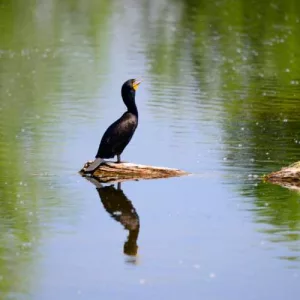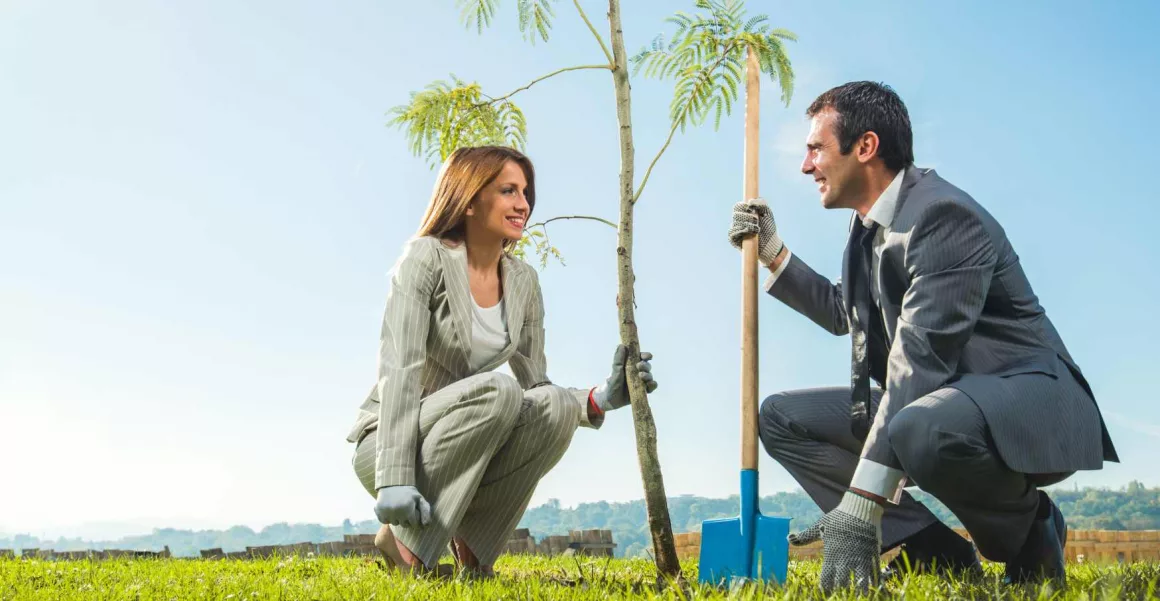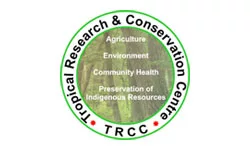Why planting trees is a good thing to do
Planting trees has several environmental and social benefits, including:

• Absorbing carbon dioxide, reducing air pollution and mitigating climate change
• Providing habitats for wildlife and preserving biodiversity
• Improving soil health and preventing soil erosion
• Enhancing water quality and reducing the risk of flooding
• Providing shade and cooling down urban areas
• Improving human health and well-being through exposure to nature
• Increasing property values and beautifying communities.
Let’s explore each one of these points in detail:
How can my company absorb carbon dioxide, reduce air pollution and mitigate climate change
• Implement energy efficiency measures: Reduce energy use and greenhouse gas emissions through efficient equipment, lighting, and building design.
• Switch to renewable energy sources: Switch to clean energy sources such as wind, solar, geothermal and hydro power.
• Promote sustainable transportation: Encourage employees to use public transportation, carpool, or bike to work.
• Implement a waste management plan: Reduce, reuse, and recycle waste to decrease emissions from landfills.
• Plant trees and green spaces: Incorporate green spaces and trees on company grounds to absorb carbon dioxide.
• Support carbon offset projects: Invest in carbon offset projects, such as reforestation or renewable energy, to mitigate emissions.
• Collaborate with suppliers: Work with suppliers to reduce their environmental impact and set sustainability targets.
• Educate employees: Raise awareness among employees about the importance of reducing carbon footprint and living sustainably.
What kind of initiatives provide habitats for wildlife and preserve biodiversity
• Tree planting organisations such as Gift a Tree
• Protected areas: Designate and manage protected areas, such as national parks, wildlife reserves, and marine conservation zones, to preserve wildlife habitat and biodiversity.
• Restoration of ecosystems: Restore damaged or destroyed ecosystems, such as wetlands, forests, and grasslands, to provide habitat for wildlife.
• Sustainable agriculture: Implement sustainable agriculture practices that protect wildlife habitat and promote biodiversity.
• Reforestation: Plant trees to restore forests and provide habitat for wildlife.
• Biodiversity corridors: Connect fragmented habitats with biodiversity corridors to facilitate the movement of wildlife.
• Anti-poaching measures: Implement measures to reduce illegal hunting, fishing, and trade of wildlife to preserve biodiversity.
• Species reintroduction programs: Reintroduce endangered species to their native habitats to increase biodiversity.
• Marine conservation: Implement measures to protect and conserve marine ecosystems, including reducing pollution, protecting vital habitats, and managing sustainable fishing practices.
 How planting trees Improves soil health and prevents soil erosion
How planting trees Improves soil health and prevents soil erosion
• Root systems: Trees have deep root systems that help to stabilise soil and prevent erosion by reducing the impact of wind and water.
• Leaf litter: Leaves from trees that fall to the ground provide organic matter to the soil, improving its fertility and structure.
• Cooling effect: Trees provide shade, reducing the temperature of the soil and slowing the rate of evaporation, reducing soil erosion caused by water.
• Rain interception: Trees intercept rainwater and reduce runoff, allowing water to slowly penetrate the soil and reducing the risk of erosion.
• Soil protection: Trees protect the soil from direct sunlight, wind, and heavy rainfall, reducing soil erosion and improving soil health.
• Reduced tillage: Trees can reduce the need for tillage in agriculture, preserving soil structure and reducing soil erosion.
• Increased moisture retention: Trees improve soil moisture retention by reducing evaporation and increasing infiltration of water into the soil.
• Enhanced microclimate: Trees create a microclimate that is more favourable for the growth of plants, improving soil health and preventing soil erosion over time.
 Planting trees Enhances water quality and reduces the risk of flooding
Planting trees Enhances water quality and reduces the risk of flooding
• Water filtration: Trees filter pollutants, such as nitrogen and phosphorus, from runoff before it enters bodies of water, improving water quality.
• Rain interception: Trees intercept rainfall and reduce runoff, slowing the flow of water and reducing the risk of flooding.
• Soil stability: Trees help to stabilize soil, reducing the risk of erosion and mudslides that can contribute to flooding.
• Groundwater recharge: Trees increase groundwater recharge by increasing water infiltration into the soil and reducing evaporation.
• Stream-bank stabilisation: Trees planted along streams and rivers help stabilise banks and reduce the risk of erosion, which can contribute to flooding.
• Reduced urban heat island effect: Trees reduce the urban heat island effect, lowering the risk of flash flooding in urban areas.
• Increased water retention: Trees increase water retention in the soil, reducing the risk of drought and improving water quality.
• Floodplain restoration: Trees can be planted in floodplains to reduce the risk of flooding and improve water quality.
 Trees provide shade and cool down urban areas
Trees provide shade and cool down urban areas
• Shade: Trees provide shade and reduce heat levels, making outdoor spaces more comfortable and cooler.
• Evapotranspiration: Trees release moisture through a process called evapotranspiration, which cools the air and reduces heat in urban areas.
• Albedo effect: Trees have a lower albedo effect compared to hard surfaces, such as concrete and asphalt, reducing the amount of heat absorbed by urban areas.
• Urban heat island effect: Trees help mitigate the urban heat island effect, where urban areas are significantly hotter than surrounding rural areas.
• Reduced air temperature: Studies have shown that planting trees in urban areas can reduce air temperature by several degrees.
• Cooling buildings: Trees provide shade to buildings, reducing the need for air conditioning and cooling energy consumption.
• Improved air quality: Trees can improve air quality by removing pollutants, such as ozone and particulate matter, from the air through a process called phytoremediation.
• Human comfort: Trees provide a sense of shade and comfort, enhancing the liveability of urban areas and reducing heat-related stress on residents.
 Planting trees improves human health and well-being
Planting trees improves human health and well-being
• Improved air quality: Trees can improve air quality by removing pollutants, such as ozone and particulate matter, from the air through a process called phytoremediation.
• Reduced stress: Spending time in green spaces, such as parks and forests, has been shown to reduce stress and improve mental health.
• Increased physical activity: Trees provide shade for outdoor recreation, encouraging people to be physically active and improving their health.
• Improved mental health: Spending time in nature and around trees has been shown to improve mood, reduce anxiety and depression, and increase overall well-being.
• Better sleep: Spending time in green spaces has been linked to improved sleep quality and reduced sleep disturbances.
• Improved cardiovascular health: Exposure to green spaces has been linked to reduced risk of cardiovascular disease and stroke.
• Enhanced cognitive function: Spending time in green spaces has been shown to improve cognitive function and creativity.
• Increased social connections: Tree-lined streets and parks provide spaces for social interaction and community building, improving overall health and well-being.
 How does planting trees increase property values and beautify communities
How does planting trees increase property values and beautify communities
• Aesthetic appeal: Trees can add beauty and visual appeal to communities, making them more attractive to residents and potential buyers.
• Increased property values: Studies have shown that properties with mature trees can have higher property values compared to properties without trees.
• Street appeal: Trees planted along streets and sidewalks can increase the curb appeal of a neighbourhood, making it more attractive to residents and potential buyers.
• Enhanced community image: Planting trees can enhance the image of a community and improve its reputation, making it more desirable for residents and potential buyers.
• Reduced noise pollution: Trees can reduce noise pollution, making communities more peaceful and desirable for residents.
• Increased privacy: Trees can provide privacy and reduce the visibility of neighbouring properties, making communities more desirable for residents.
• Improved walkability: Tree-lined streets and sidewalks can improve walkability and encourage people to walk more, improving community health and well-being.
• Community pride: Planting trees can encourage community involvement and pride, leading to stronger community bonds and a more desirable community for residents.


















